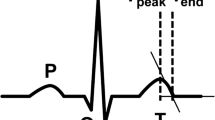Abstract
Objective
Although carotid artery stenting (CAS) is an effective treatment for severe carotid stenosis, it has been associated with alterations in autonomic functions during or shortly after the procedure. And, autonomic functions influence P-wave durations. In this study, our aim was to investigate P-wave durations on 12-lead surface electrocardiography after CAS.
Methods
Patients (19 male, 8 female) who are suitable for CAS, without a history of hypertension, diabetes mellitus, severe coronary artery or valvular heart disease, were enrolled in our study. 12-lead surface electrocardiography recordings were obtained at the beginning, immediately after and at the 24 h of the procedure. P-wave maximum, minimum and dispersion durations were analyzed by double-blinded observers. Results were statistically analysed using Friedman and Wilcoxon tests.
Results
The P maximum and P dispersion values were significantly increased immediately after the procedure and continued with high levels at 24-h recordings, respectively (128 ± 10/19 ± 7, 143 ± 14/37 ± 11, and 137 ± 11/30 ± 7 ms, p value <0.05). The P minimum value was significantly decreased immediately after the procedure (109 ± 11/105 ± 10 ms, p value <0.05). At 24-h recordings, a nonsignificant increase occured in P minimum values (106 ± 8 ms).
Conclusions
P maximum and dispersion durations were significantly increased after the CAS and continued with high levels at 24-h recordings, which may be associated with the alterations in autonomic functions via augmented parasympathetic activity by vagally mediated stimulus. Overall, these findings suggest that decline in cardiovascular activity is prolonged at least 24 h after CAS.
Similar content being viewed by others
References
Knur R (2009) Carotid artery stenting: a systematic review of randomized clinical trials. Vasa 38(4):281–291
Dangas G, Laird JR Jr, Satler LF et al (2000) Postprocedural hypotension after carotid artery stent placement: predictors and short- and long-term clinical outcomes. Radiology 215(3):677–683
Gupta R, Abou-Chebl A, Bajzer CT et al (2006) Rate, predictors, and consequences of hemodynamic depression after carotid artery stenting. J Am Coll Cardiol 47(8):1538–1543
Kosar F, Aksoy Y, Arı F et al (2008) P-wave duration and dispersion in obese subjects. Ann Noninvasive Electrocardiol 13:3–7
Ozer N, Aytemir K, Atalar E et al (2000) P wave dispersion in hypertensive patients with paroxysmal atrial fibrillation. Pacing Clin Electrophysiol 23:1859–1862
Dilaveris PE, Gialafos EJ, Andrikopoulos GK et al (2000) Clinical and electrocardiographic predictors of recurrent atrial fibrillation. Pacing Clin Electrophysiol 23(3):352–358
NASCET Collaborators (1991) Beneficial effect of carotid endarterectomy in symptomatic patients with high-grade carotid stenosis. N Engl J Med 325(7):445–453
Mangin L, Medigue C, Merle JC et al (2003) Cardiac autonomic control during balloon carotid angioplasty and stenting. Can J Physiol Pharmacol 81(10):944–951
La Rovere MT, Pinna GD, Raczak G (2008) Baroreflex sensitivity: measurement and clinical implications. Ann Noninvasive Electrocardiol 13(2):191–207
Demirci M, Saribaş O, Uluç K et al (2006) Carotid artery stenting and endarterectomy have different effects on heart rate variability. J Neurol Sci 241(1–2):45–51
Coumel P (1994) Paroxysmal atrial fibrillation: a disorder of autonomic tone? Eur Heart J 15(Suppl A):9–16
Chen YJ, Chen SA, Tai CT et al (1998) Role of atrial electrophysiology and autonomic nervous system in patients with supraventricular tachycardia and paroxysmal atrial fibrillation. J Am Coll Cardiol 32(3):732–738
Mehlsen J, Kaijer MN, Mehlsen AB (2008) Autonomic and electrocardiographic changes in cardioinhibitory syncope. Europace 10(1):91–95 (Epub 2007 Oct 30)
Yakhou L, Constant I, Merle JC et al (2006) Noninvasive investigation of autonomic activity after carotid stenting or carotid endarterectomy. J Vasc Surg 44(3):472–479
Huang CC, Wu YS, Chen T et al (2010) Long-term effects of baroreflex function after stenting in patients with carotid artery stenosis. Auton Neurosci 158(1–2):100–104
Dilaveris PE, Gialafos EJ, Sideris SK, Theopistou AM et al (1998) Simple electrocardiographic markers for the prediction of par-oxysmal idiopathic atrial fibrillation. Am Heart J 135:733–738
Conflict of interest
None.
Author information
Authors and Affiliations
Corresponding author
Rights and permissions
About this article
Cite this article
Alici, G., Ozkan, B., Yazicioglu, M.V. et al. P-wave dispersion by 12-lead electrocardiography in carotid artery stenting. Clin Auton Res 23, 81–84 (2013). https://doi.org/10.1007/s10286-012-0186-2
Received:
Accepted:
Published:
Issue Date:
DOI: https://doi.org/10.1007/s10286-012-0186-2




